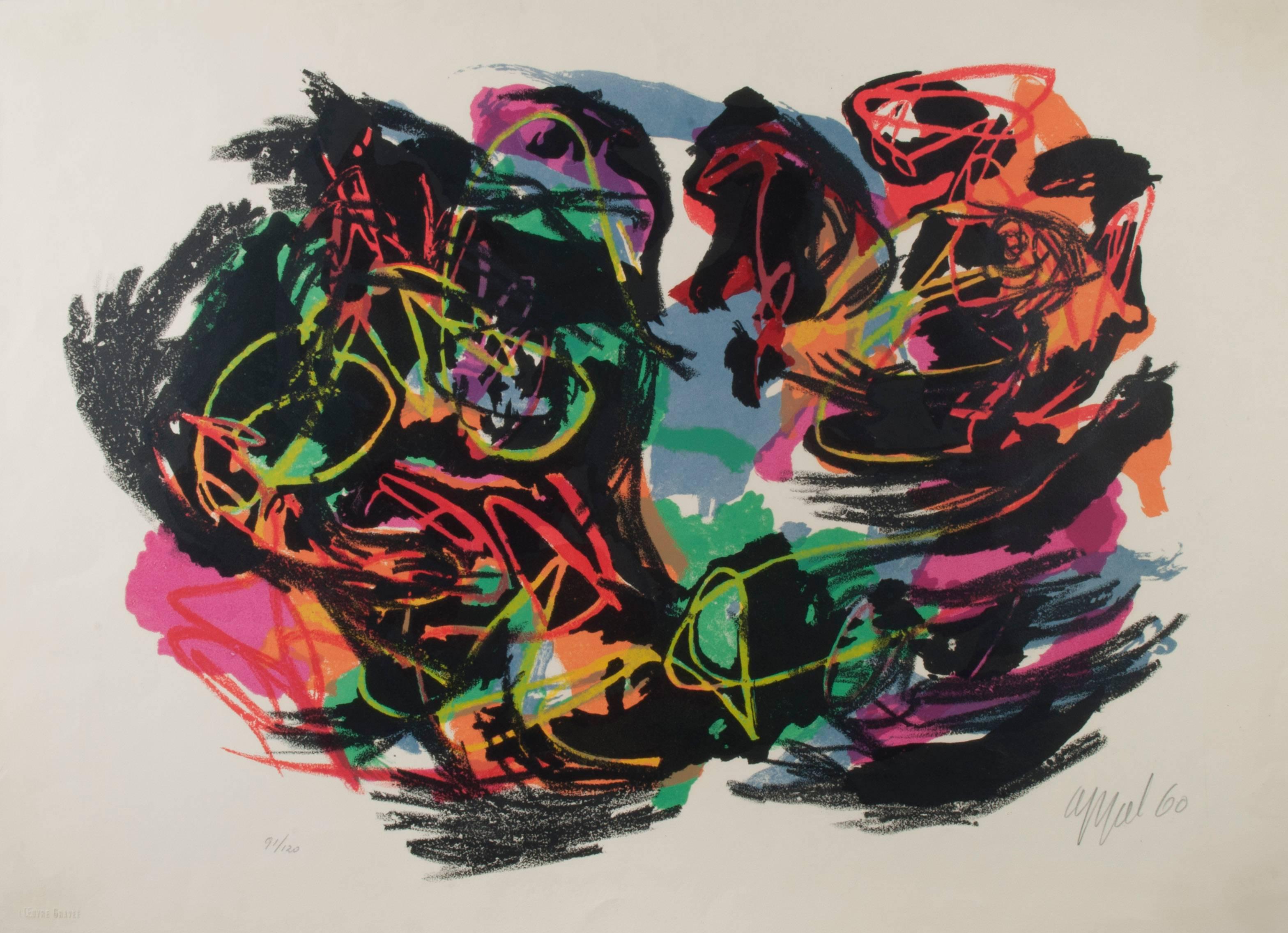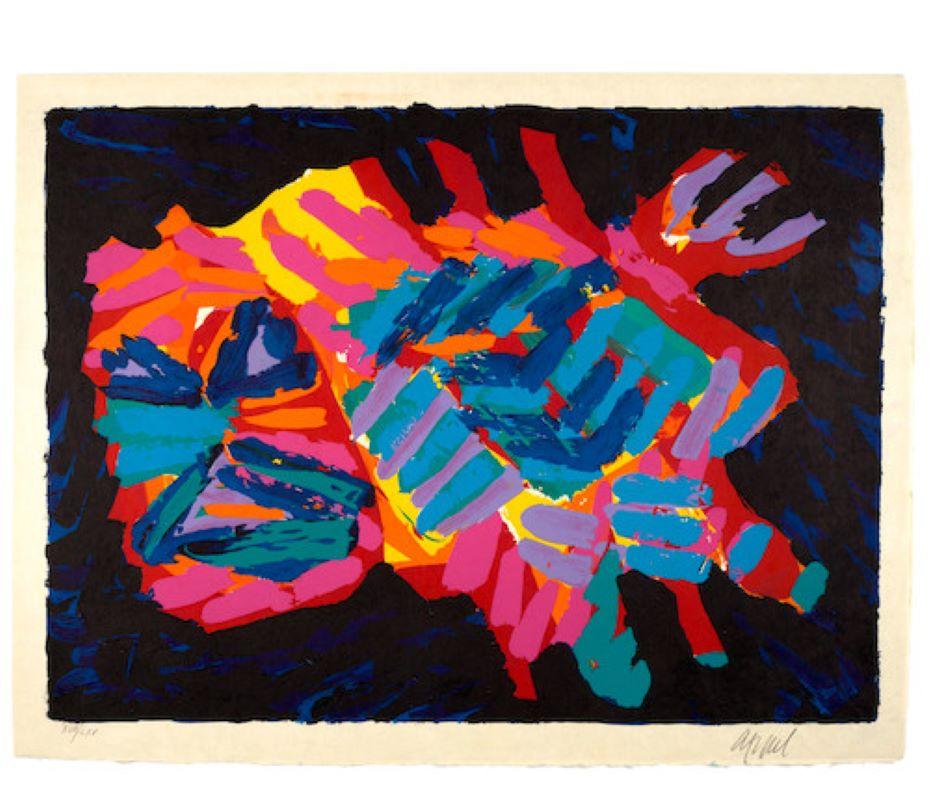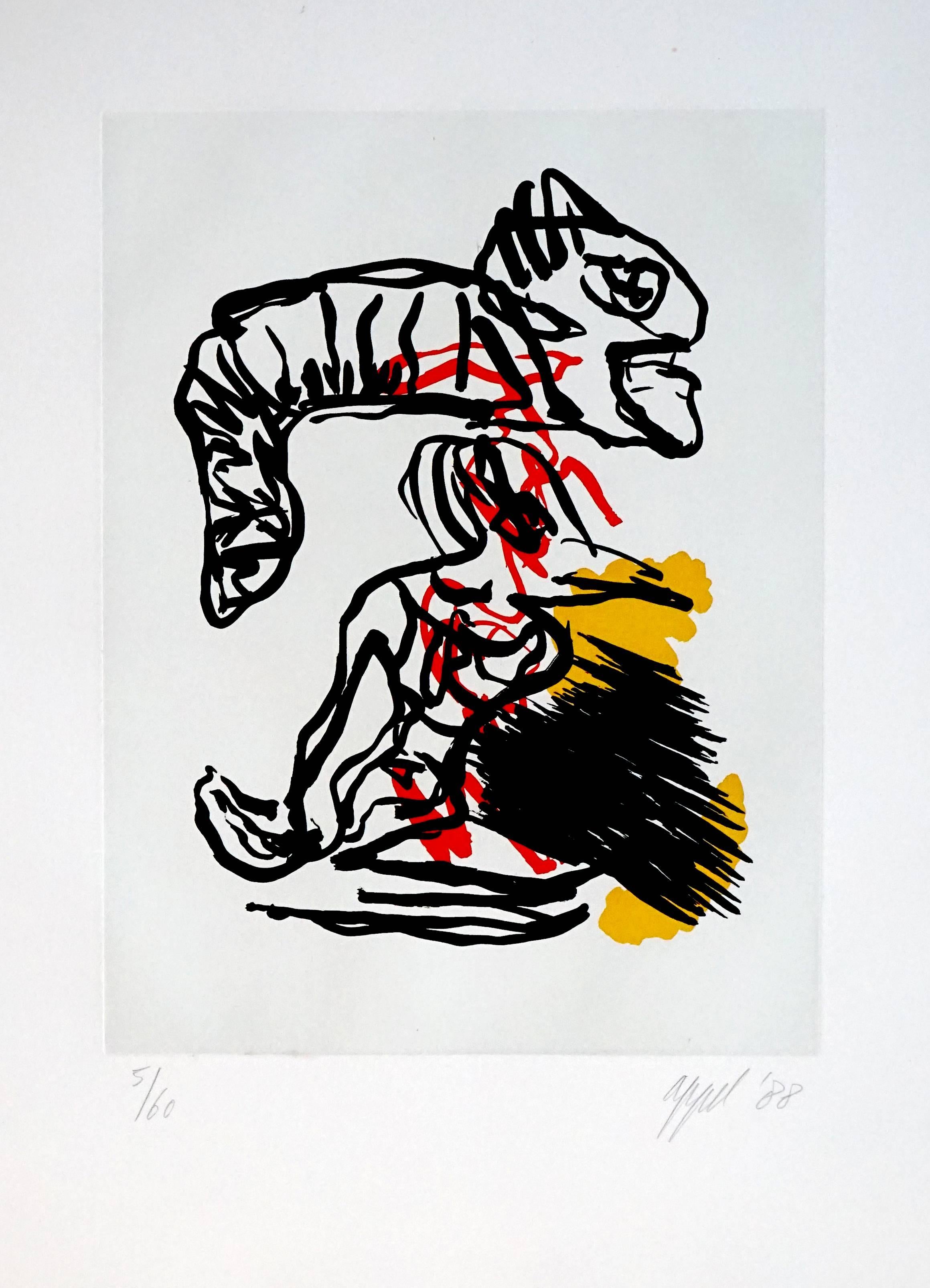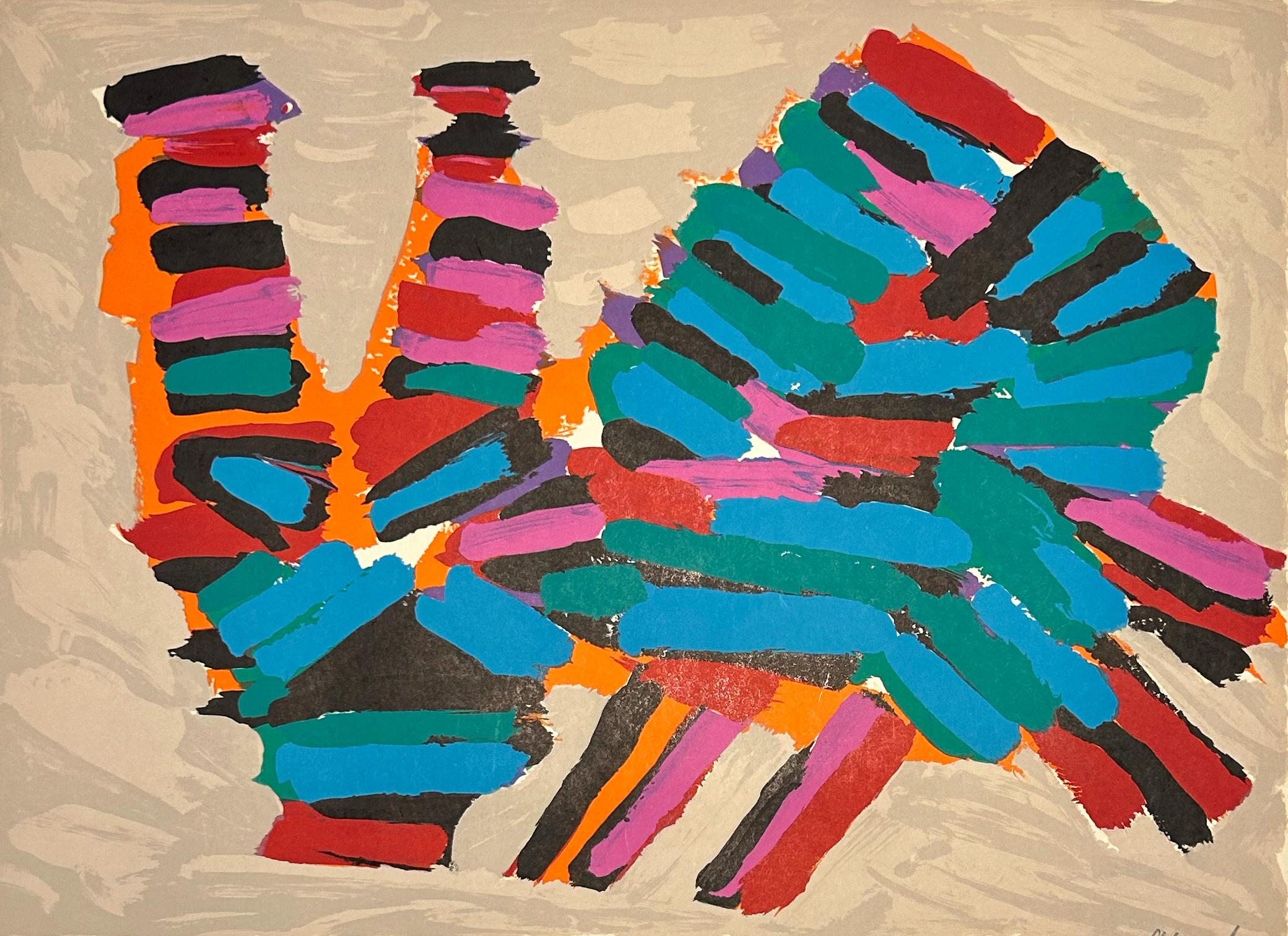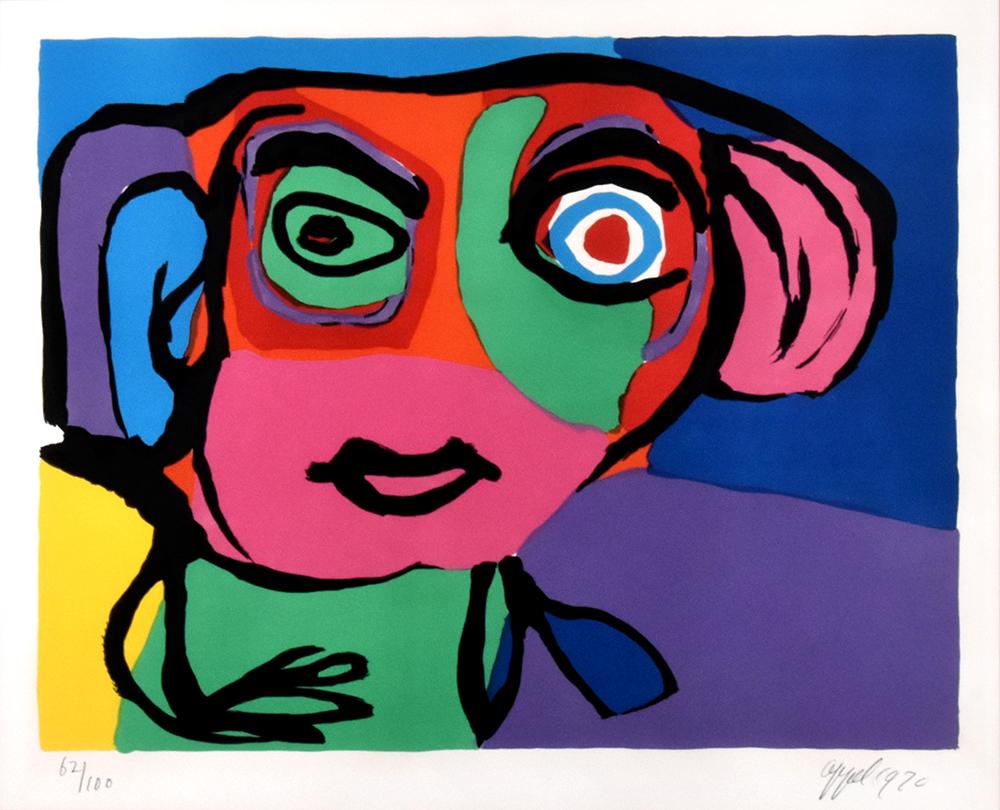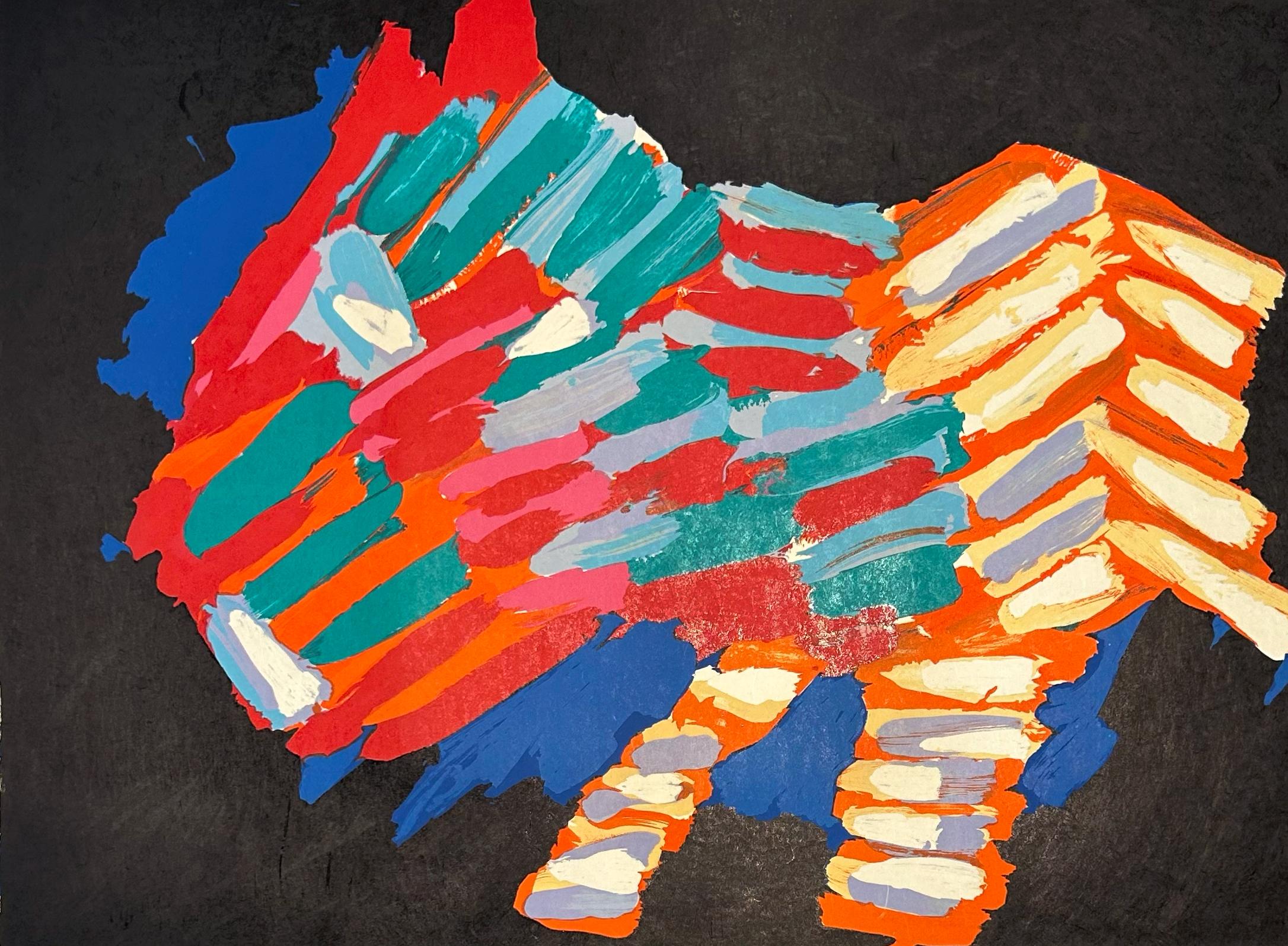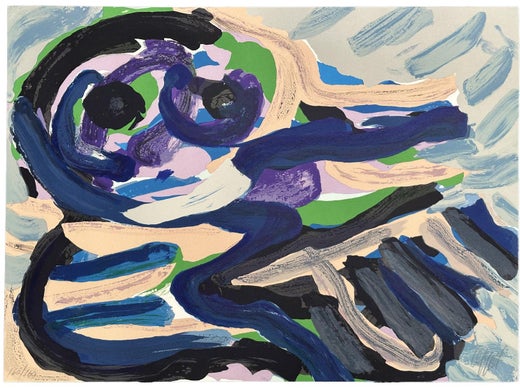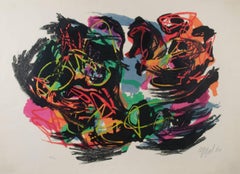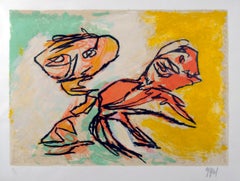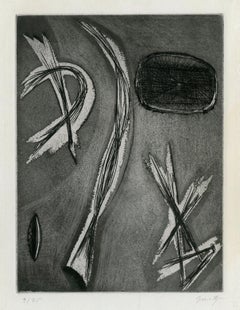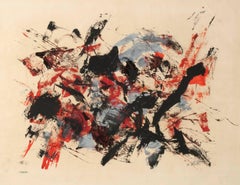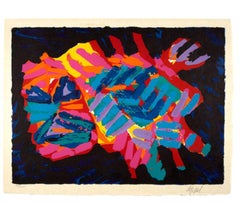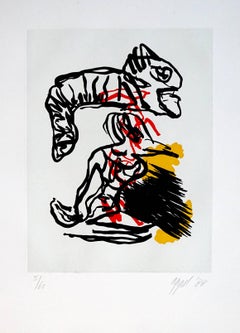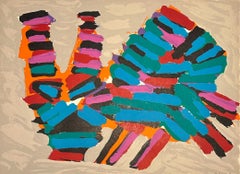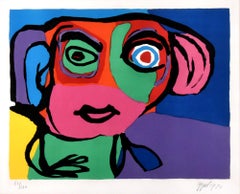Want more images or videos?
Request additional images or videos from the seller
1 of 11
Karel AppelNightfear1958
1958
$5,000
£3,873.58
€4,412.48
CA$7,158.69
A$7,817.84
CHF 4,103.70
MX$93,767.99
NOK 51,684.02
SEK 48,551.18
DKK 32,948.81
About the Item
Nightfear
Color lithograph, 1958
From: Rhapsodie de ma nuit, (seven plates)
Signed, dated and numbered in pecnil lower left (see photos)
Edition: E.A. edition of 25, (there were also 75 impressions numbered)
Condition: Excellent, fresh colors and condition
Thin spots on reverse from previous hinges
Provenance: Martha Jackson Gallery
David Anderson Gallery
David Anderson granndchildren Trust
References And Exhibitions:
This portfolio is considered to be one of the greatest-and rarest-illustrated book of the Cobra movement. A copy of this livre d’artiste is in the collection of MOMA. This lithograph is one of four works in color in the portfolio. The book was authored by Emmanuel Looten and published by S.I. (Paris).
VERY IMPORTANT EARLY COBRA WORK OF ART
Karel Appel
B. 1921, AMSTERDAM; D. 2006, ZURICH
Karel Appel was born on April 25, 1921, in Amsterdam. From 1940 to 1943 he studied at the Rijksakademie van Beeldende Kunsten, Amsterdam. In 1946 his first solo show was held at Het Beerenhuis, Groningen, Netherlands, and he participated in Jonge Schilders (Young painters) at the Stedelijk Museum, Amsterdam. About this time, Appel was influenced first by Pablo Picasso and Henri Matisse, then by Jean Dubuffet. He was a member of the Nederlandse Experimentele Groep (Dutch Experimental Group, 1948) and established the Cobra group (1948–51) with Constant (Constant Nieuwenhuys), Corneille (Guillaume Cornelis Beverloo), and other painters from Copenhagen, Brussels, and Amsterdam. The style distinguished itself through bold, expressive compositions inspired by folk and children's art, as well as by the work of Paul Klee and Joan Miró. In 1949 Appel completed a fresco for the cafeteria of the city hall in Amsterdam, which created such controversy that it was covered for ten years.
In 1950 the artist moved to Paris; there the writer Hugo Claus introduced him to art critic Michel Tapié, who organized various exhibitions of his work. Appel was given a solo show at the Palais des beaux-arts, Brussels, in 1953. He received the UNESCO Prize at the 1954 Venice Biennale and was commissioned to execute a mural for the restaurant of the Stedelijk Museum in 1956. The following year Appel traveled to Mexico and the United States and won a graphics prize at the Ljubljana Biennial in Yugoslavia. The first major monograph on Appel, written by Claus, was published in 1962. In the late 1960s, the artist moved to the Château de Molesmes, near Auxerre, southeast of Paris. Solo exhibitions of his work were held at the Centre national d'art contemporain, Paris, and the Stedelijk Museum (1968), and at the Kunsthalle Basel and the Palais des beaux-arts (1969). During the 1950s and 1960s he executed numerous murals for public buildings. A major Appel show opened at the Centraal Museum, Utrecht, Netherlands (1970), and a retrospective toured Canada and the United States (1972).
In the 1970s and 1980s, Appel continued to work simultaneously in sculpture and painting, pushing his abstraction further with his window paintings—a series he began in 1980. Appel also gradually introduced landscape into his iconography, which would develop into a more consistent engagement in the last decade of his work. In the 1980s, Appel also began his collaborations with American poet Allen Ginsberg, which would continue over the next ten years. In his later career, his work was the subject of numerous solo exhibitions organized by Museum Boijmans Van Beuningen, Rotterdam (1982); Castello di Rivoli–Museo d'arte contemporanea, Turin, Italy (1987); National Museum of Art, Osaka (1989); Stedelijk Museum (1998, 2000, and 2001); and Cobra Museum voor Moderne Kunst, Amstelveen, Netherlands (2001). Appel died on May 3, 2006, in Zurich."
Courtersy Guggenheim
- Creator:Karel Appel (1921 - 2006, Dutch)
- Creation Year:1958
- Dimensions:Height: 10.13 in (25.74 cm)Width: 12.94 in (32.87 cm)
- Medium:
- Movement & Style:
- Period:
- Condition:
- Gallery Location:Fairlawn, OH
- Reference Number:Seller: FA108631stDibs: LU14014779862
Karel Appel
Karel Appel was a founding member of COBRA, an art movement originating in Germany that strived to replicate and invoke the child’s approach to art. Within this movement he created abstracted and simplified figures, often monsters and fractured depictions of people.
About the Seller
5.0
Recognized Seller
These prestigious sellers are industry leaders and represent the highest echelon for item quality and design.
Gold Seller
Premium sellers maintaining a 4.3+ rating and 24-hour response times
Established in 1978
1stDibs seller since 2013
821 sales on 1stDibs
Typical response time: <1 hour
Associations
International Fine Print Dealers Association
- ShippingRetrieving quote...Shipping from: Fairlawn, OH
- Return Policy
Authenticity Guarantee
In the unlikely event there’s an issue with an item’s authenticity, contact us within 1 year for a full refund. DetailsMoney-Back Guarantee
If your item is not as described, is damaged in transit, or does not arrive, contact us within 7 days for a full refund. Details24-Hour Cancellation
You have a 24-hour grace period in which to reconsider your purchase, with no questions asked.Vetted Professional Sellers
Our world-class sellers must adhere to strict standards for service and quality, maintaining the integrity of our listings.Price-Match Guarantee
If you find that a seller listed the same item for a lower price elsewhere, we’ll match it.Trusted Global Delivery
Our best-in-class carrier network provides specialized shipping options worldwide, including custom delivery.More From This Seller
View AllDrole de Drame
By Karel Appel
Located in Fairlawn, OH
Drole de Drame
Lithograph, 1960
Signed, dated and numbered in pencil lower right
(see photos)
Edition: 120 (91/120)
Published by L’Ouevre Grave, Geneve (blindstamp recto)
Printed by ...
Category
1960s Abstract Abstract Prints
Materials
Lithograph
Sprong in de Lente (Deux Personnages)
By Karel Appel
Located in Fairlawn, OH
Sprong in de Lente (Deux Personnages)
Color lithograph, 1963
Signed, dated and numbered in pencil (see photos)
Edition: 25
Signed, dated and numbered in pencil
Printed on Arches pape...
Category
1960s Abstract Abstract Prints
Materials
Lithograph
Untitled
By Henri Goetz
Located in Fairlawn, OH
Untitled
Engraving, drypoint & carborundum, c. 1960's
Signed and numbered in pencil (see photos)
Edition: 25 (9/25)
Printed by the artist
Condition: Adhesive residue on the verso to...
Category
1960s Abstract Expressionist Abstract Prints
Materials
Engraving
Untitled Abstraction
By John von Wicht
Located in Fairlawn, OH
Untitled Abstrraction
Gouache, watercolor and pigments on paper, c. 1960
Signed lower right in pencil (see photo)
Image: 17 x 22 inches
Sheet: 25 1/4 x 29 3/4 inches
Frame: 25 1/4 x ...
Category
1960s Abstract Expressionist Abstract Drawings and Watercolors
Materials
Watercolor
Untitled
By Henri Goetz
Located in Fairlawn, OH
Untitled
Signed in pencil lower right (see photo)
Edition: 25 (9/25) (see photo)
Engraving, drypoint & carborundum
Printed by the artist
Condition: Excellent, slight residue on rever...
Category
1960s Abstract Expressionist Abstract Prints
Materials
Drypoint, Etching
Untitled (Martha Jackson Gallery Poster)
By Walasse Ting
Located in Fairlawn, OH
Untitled (Martha Jackson Gallery Poster)
Lithograph, 1960
Signed and dated in red crayon by the artist
Edition 90 (63/90)
1st state before letters for the poster created for the Martha Jackson Gallery, Ting Exhibition, April 23-May 31, 1960
Printed on wove paper with a ”JAPAN' watermark
Edition: 90
Provenance: Martha Jackson Gallery, New York
Anderson Gallery
David K. Anderson Collection (label)
Walasse Ting (Chinese: 丁雄泉, 13 October 1929 – May 17, 2010)[1] was a Chinese-American visual artist and poet. His colorful paintings have attracted critical admiration and a popular following. Common subjects include nude women and cats, birds and other animals.
He was born on 13 October 1929 in Shanghai, left China in 1946 and lived for a while in Hong Kong, then settled in Paris in 1952.[2] There, he associated with artists such as Karel Appel, Asger Jorn, and Pierre Alechinsky, members of the avant-garde group CoBrA. Ting started his career as an artist in Paris in the 1950s, where he became friends with artists such as Sam Francis and Pierre Alechinsky. His early works were influenced by the CoBrA group, a European art movement known for its use of expressive, childlike imagery. In the 1960s, Ting moved to New York City and became associated with the Pop Art movement. Ting is perhaps best known for his series of paintings featuring women, which he called "Cat Women...
Category
1960s Abstract Abstract Prints
Materials
Lithograph
You May Also Like
Devil Cat
By Karel Appel
Located in Philadelphia, PA
Artist: Karel Appel
Title: Devil Cat
Suite: Cats Portfolio
Year: 1979
Medium: Original lithograph in colors on Japon paper
Edition: From the limited edi...
Category
1970s Prints and Multiples
Materials
Lithograph
Salto Sobre La Cabeza
By Karel Appel
Located in Austin, TX
Artist: Karel Appel
Title: Salto Sobre La Cabeza
Year: 1988
Medium: Etching with aquatint
Signed and dated '88, numbered 5/60 in pencil
Dimensions: 19.25" x 4.5"
Provenance: Gallery ...
Category
1980s Expressionist Abstract Prints
Materials
Etching, Aquatint
$990 Sale Price
40% Off
Frightened Cat
By Karel Appel
Located in Washington, DC
Artist: Karel Appel
Title: Frightened Cat
Portfolio: 1978 Cats
Medium: Lithograph in colors on Japon paper
Date: 1978
Edition: XV/LXV
Sheet Size: 24 3/4" x 32 1/4"
Signature: Hand si...
Category
1970s Abstract Animal Prints
Materials
Lithograph
Composition II
By Karel Appel
Located in Palo Alto, CA
Whimsical in nature, the exuberant application of color captures a quality of spontaneity and experimentation. Famous for the "Dupe of Being" in which he strives to combine the tragi...
Category
1970s Modern Figurative Prints
Materials
Lithograph
$7,000 Sale Price
30% Off
Cat in the Night
By Karel Appel
Located in Washington, DC
Artist: Karel Appel
Title: Cat in the Night
Portfolio: 1978 Cats
Medium: Lithograph in colors on Japon paper
Date: 1978
Edition: XV/LXV
Sheet Size: 24 3/4" x 32 1/4"
Signature: Hand ...
Category
1970s Abstract Animal Prints
Materials
Lithograph
original lithograph
By Karel Appel
Located in Henderson, NV
Medium: original lithograph. Printed in 1964 and published by Eberhard Kornfeld for the 1 Cent Life portfolio in an edition of 2000. Size: 16 1/4 x 11 3/8 inches (408 x 288 mm). Ther...
Category
1960s Prints and Multiples
Materials
Lithograph
More Ways To Browse
Childrens Folk Art
Alexander Calder 1963
Antonio Luna
Barcelona Suite
Bernd Zimmer
Birth Of Venus Botticelli
Calder Dlm
Calder Lithograph 1972
Charlie Waite
Ellsworth Kelly Galerie Maeght
Expressionist Erotic Art
Georges Chakra
Gerhard Richter Signed
Gudmund Olsen
Had Gadya
Howardena Pindell
Ida Shoichi
Jamie Hewlett
